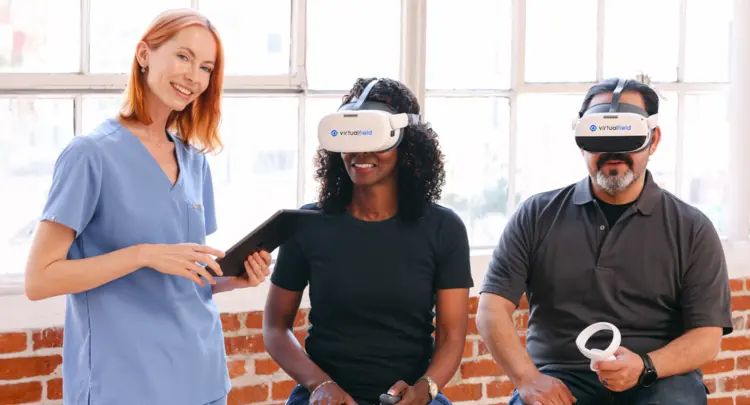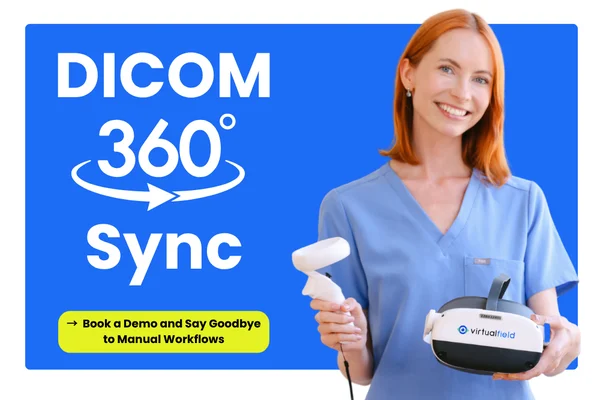Advancements in technology are reshaping how practitioners approach patient care. A recent study published by Investigative Ophthalmology & Visual Science revealed that 75% of ophthalmologists believe adopting new technologies will improve their practice. One groundbreaking innovation that has captured the attention of specialists is Virtual Field, a VR headset that conducts visual field exams, color vision, and more. This advanced solution not only enhances the accuracy and speed of visual field exams but also transforms the overall patient experience. In this article, we explore five major benefits of Virtual Field and why ophthalmologists are increasingly embracing it in their practices.

Why Ophthalmologists Are Embracing Virtual Field
Virtual Field has gained widespread adoption among ophthalmologists for several reasons. If you are considering adopting it for your practice, here are five major benefits to support your decision.
1. It conducts high-speed exams.
Many ophthalmologists favor Virtual Field due to its ability to conduct high-speed visual field exams with precision and efficiency. Traditional visual field testing often requires significant time, causing patient discomfort and limiting practice throughput. Virtual Field significantly reduces the duration of exams by leveraging advanced algorithms and streamlined testing protocols.
This speed not only enhances patient comfort but also allows ophthalmologists to perform more tests in less time without compromising diagnostic accuracy. By minimizing test duration, Virtual Field helps practices improve workflow, optimize patient scheduling, and ultimately deliver faster, high-quality care. These efficiency gains are especially important in busy practices where maximizing time is critical to managing high patient volumes effectively.
2. It enhances test accuracy.
Virtual Field is embraced by ophthalmologists for its ability to deliver highly accurate visual field exams. Utilizing sophisticated algorithms like BOLT and precise data analysis, Virtual Field minimizes human error and variability commonly associated with traditional testing methods. The technology’s advanced eye-tracking features ensure that even slight patient movements do not compromise the results, leading to more reliable assessments.
Virtual Field's accuracy extends to detecting subtle visual field defects, making it a valuable tool for early diagnosis of conditions such as glaucoma. By providing consistent and dependable results, Virtual Field enables ophthalmologists to make informed clinical decisions, ensuring patients receive appropriate care based on precise and comprehensive visual field data.
3. It streamlines workflows and maximizes clinic efficiency.
Virtual Field significantly streamlines workflows in ophthalmology clinics, enhancing overall efficiency. By reducing the time required for visual field testing, it allows clinics to manage higher patient volumes without sacrificing the quality of care. Automated test protocols and user-friendly interfaces minimize the need for extensive technician involvement, freeing up staff to focus on other critical tasks.
Additionally, DICOM 360 Sync is an automatic, realtime, bi-directional data sync designed to eliminate wasted time, reduce human error, and deliver seamless interoperability—included in Pro at no extra cost. Validated in real clinics, it saves minutes per exam, increase throughput, and improve both staff and patient experiences.
As a result, clinics can operate more efficiently, improving both clinical outcomes and business performance.
4. The advanced technology results in detailed exams.
The advanced technology that Virtual Field offers enables ophthalmologists to conduct detailed and comprehensive visual field exams with greater precision. By employing high-resolution sensors and cutting-edge algorithms, the system captures minute visual defects that may be overlooked in traditional tests.
For example, Virtual Field offers standard threshold perimetry, which measures the sensitivity of different parts of the visual field, and suprathreshold testing, designed to quickly identify areas of significant vision loss. The system also supports tests like kinetic perimetry, useful for assessing peripheral vision, and 10-2 testing, which focuses on the central visual field to detect conditions like macular degeneration.
By offering such a wide range of technology and testing options, Virtual Field provides ophthalmologists with a comprehensive toolkit to evaluate both central and peripheral vision, allowing for thorough and detailed assessments that are critical for accurate diagnosis and ongoing disease management.
5. It helps maintain regulatory compliance.
Virtual Field plays a crucial role in helping ophthalmologists maintain regulatory compliance, particularly with industry standards and guidelines for visual field testing. The system’s automated testing protocols ensure consistency and adherence to established clinical standards, reducing the risk of human error.
Virtual Field's integration with electronic health record (EHR) systems facilitates proper documentation, ensuring that patient data is accurately recorded and easily accessible for audits or reviews. The technology also supports compliance with billing and coding requirements by generating standardized reports that meet regulatory criteria.
This streamlined approach to documentation and reporting not only simplifies compliance but also reduces administrative burdens, allowing practices to focus on patient care while remaining aligned with healthcare regulations.
Case Studies from Ophthalmologists Using Virtual Field
Ophthalmologists using Virtual Field are experiencing the benefits firsthand. The following three case studies demonstrate the real-world impact this technology has on the eye care industry.
Case Study: Dr. Jonathan Kahn, ophthalmologist specializing in cornea, cataract, and refractive
Dr. Kahn implemented Virtual Field to enhance both patient satisfaction and practice efficiency. Initially discovered at the 2018 American Academy of Ophthalmology (AAO) conference, Virtual Field addressed inefficiencies in testing processes and patient flow, especially in glaucoma management. The portability of the device allowed tests to be administered in any exam room, improving scheduling and reducing appointment wait times. Virtual Field also significantly increased patient satisfaction, with many praising its comfort and ease. Dr. Kahn appreciated the user-friendly data interpretation and software improvements, highlighting the color-coded results as a helpful feature for clinicians transitioning to the system.
Case Study: Dr. Carly Seidman, ophthalmologist and medical retina specialist
Dr. Seidman transformed her practice by adopting Virtual Field after discovering it at a Virtual AAO meeting. Faced with space constraints and the need for a portable solution, she found Virtual Field ideal for her small clinic, using a converted room for testing. The device's portability also made it accessible to patients with limited mobility. Virtual Field’s 24-2 and 10-2 protocols allowed Dr. Seidman to effectively monitor glaucoma and perform hydroxychloroquine screenings. Additionally, its Ptosis examination helped secure insurance approvals for blepharoplasties, enhancing both patient care and operational efficiency in her practice.
Case Study: Dr. James Murphy, ophthalmologist and board-certified glaucoma specialist
Dr. Murphy adopted Virtual Field to address challenges with traditional visual field testing for his elderly, mobility-limited patients. Initially skeptical about the use of virtual reality (VR) headsets for older patients, he found that Virtual Field's intuitive design significantly improved patient comfort, especially for those with spine or neck issues. The device’s multilingual audio instructions enhanced accessibility for non-English speakers and streamlined staff workflows. Additionally, Virtual Field's clinical accuracy matched traditional methods, while its subscription model and operational efficiencies provided a strong return on investment, making it a valuable addition to his practice.
⭐️ Bonus Content: To help you prepare your patients for their visual field test, and ensure they feel informed and comfortable, download our patient handout, What to Expect from Your Visual Field Test Today which can be shared via patient portal or displayed in your exam room.
Key Takeaways: Why Ophthalmologists Choose Virtual Field
Virtual Field offers ophthalmologists a powerful solution for improving visual field testing and overall clinic efficiency. Here are the key reasons why many are embracing this advanced technology:
- Faster Exams: Virtual Field conducts high-speed exams, reducing patient discomfort and allowing clinics to see more patients without compromising diagnostic accuracy.
- Enhanced Accuracy: With advanced eye-tracking and data analysis, Virtual Field delivers precise results, minimizing human error and improving early disease detection.
- Streamlined Workflows: The technology integrates seamlessly into clinic operations, optimizing workflows and freeing up staff for other critical tasks.
- Comprehensive Testing: Virtual Field supports a variety of detailed exams, from threshold perimetry to kinetic testing, offering comprehensive assessments of both central and peripheral vision.
- Regulatory Compliance: Automated protocols and EHR integration help practices maintain compliance with industry standards.
By adopting Virtual Field, ophthalmologists can enhance patient care while improving clinic efficiency and accuracy. To learn more about how Virtual Field can benefit your ophthalmic practice, schedule a demo today.
About Virtual Field
Virtual Field delivers an exceptional eye exam experience. Eye care professionals including ophthalmologists and optometrists examine patients faster, more efficiently, and more comfortably than ever before. Exams include Visual Field, 24-2, Kinetic Visual Field (Goldmann Perimetry), Ptosis, Esterman, Color Vision, Pupillometry, Extraocular Motility (EOM), and more.



